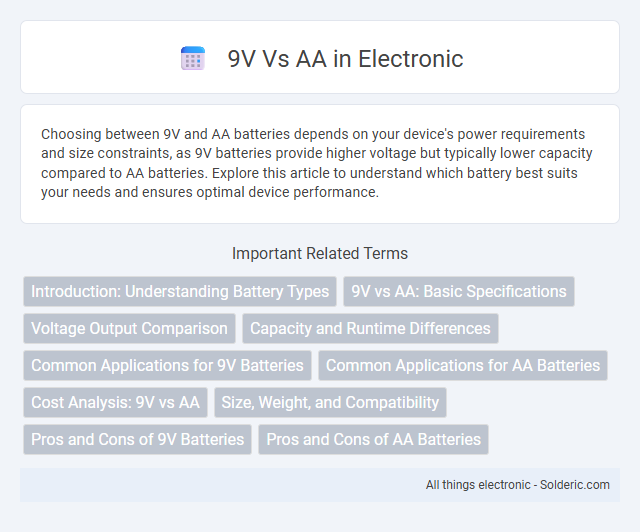Choosing between 9V and AA batteries depends on your device's power requirements and size constraints, as 9V batteries provide higher voltage but typically lower capacity compared to AA batteries. Explore this article to understand which battery best suits your needs and ensures optimal device performance.
Comparison Table
| Feature | 9V Battery | AA Battery |
|---|---|---|
| Voltage | 9 Volts | 1.5 Volts |
| Size | 48.5 mm x 26.5 mm x 17.5 mm | 50.5 mm x 14.5 mm (approximate cylindrical) |
| Capacity | 500-600 mAh (alkaline) | 1800-2600 mAh (alkaline) |
| Common Uses | Smoke detectors, transistor radios, guitars | Remote controls, flashlights, toys |
| Weight | Approx. 45 grams | Approx. 23 grams |
| Rechargeable Options | NiMH rechargeable 8.4V approx. | NiMH rechargeable 1.2V |
| Cost | Higher price per battery | Lower price per battery |
Introduction: Understanding Battery Types
9V batteries offer a compact rectangular shape and higher voltage output suitable for devices requiring steady power, while AA batteries provide a versatile cylindrical design with lower voltage but higher capacity options. AA batteries are widely used in everyday electronics such as remote controls, flashlights, and toys due to their availability and cost-effectiveness. Understanding the voltage, size, and capacity differences between 9V and AA batteries is essential for selecting the appropriate power source for specific electronic devices.
9V vs AA: Basic Specifications
A 9V battery typically provides 9 volts of power with a capacity around 500-600mAh, making it suitable for devices requiring higher voltage but shorter runtime. AA batteries offer 1.5 volts with capacities ranging from 1800mAh to 3000mAh, providing longer usage in low-drain devices. The size difference is notable, with the 9V battery being larger and heavier compared to the compact AA cell.
Voltage Output Comparison
A 9V battery delivers a consistent voltage output of 9 volts, making it suitable for devices requiring higher voltage levels. In contrast, a standard AA battery typically provides 1.5 volts per cell, often used in multiples for devices needing lower voltages or higher capacities. Comparing voltage output is crucial for selecting the appropriate power source to match the electrical requirements of specific electronic devices.
Capacity and Runtime Differences
9V batteries typically have a capacity of around 500-600mAh, whereas AA batteries offer significantly higher capacities, often ranging from 1800 to 3000mAh depending on the type (alkaline or rechargeable NiMH). This difference directly impacts runtime, with AA batteries providing longer operation for devices due to their greater energy storage. Your choice between 9V and AA should consider the device's power consumption and required runtime to ensure optimal performance.
Common Applications for 9V Batteries
9V batteries are commonly used in smoke detectors, transistor radios, and walkie-talkies due to their compact size and higher voltage output compared to AA batteries. These batteries provide reliable, long-lasting power for devices requiring stable voltage over extended periods. Their rectangular shape and snap connectors make them ideal for applications where space-saving and easy replacement are essential.
Common Applications for AA Batteries
AA batteries are widely used in common household devices such as remote controls, digital cameras, flashlights, and wireless computer peripherals. Their moderate size and voltage output of 1.5V make them ideal for low to medium power consumption gadgets. Unlike 9V batteries, AA cells are more versatile and cost-effective for everyday electronics requiring reliable, long-lasting power.
Cost Analysis: 9V vs AA
AA batteries typically cost less per unit and offer a higher milliamp-hour (mAh) rating, providing longer usage duration compared to most 9V batteries. A 9V battery, while more compact, generally has a higher price per battery and lower overall energy capacity, making it less cost-effective for devices requiring extended power. Evaluating Your device's energy needs alongside the price per battery and total battery life can help determine whether 9V or AA batteries provide the best value.
Size, Weight, and Compatibility
9V batteries are typically larger and heavier, measuring around 48mm x 26.5mm x 17.5mm and weighing approximately 45 grams, while AA batteries are smaller at about 50mm x 14mm in size and weigh around 23 grams. The 9V battery delivers 9 volts, making it suitable for devices requiring higher voltage, whereas AA batteries provide 1.5 volts each and are commonly used in a wide range of electronics through series or parallel arrangements. Choosing between 9V and AA batteries depends on your device's voltage requirements and physical space constraints, ensuring optimal compatibility.
Pros and Cons of 9V Batteries
9V batteries offer a compact design with higher voltage output, making them ideal for devices like smoke detectors and guitar pedals. However, their relatively lower capacity and shorter lifespan compared to AA batteries can lead to more frequent replacements. Your choice depends on device requirements and usage patterns, balancing voltage needs against battery longevity.
Pros and Cons of AA Batteries
AA batteries offer high availability and cost-effectiveness, making them ideal for everyday devices like remote controls and toys. They typically provide longer runtime in low to moderate drain devices due to their larger capacity compared to 9V batteries. However, AA batteries have lower voltage output (1.5V per cell) and may require more cells to achieve the needed power for certain electronics, increasing size and weight.
9V vs AA Infographic

 solderic.com
solderic.com